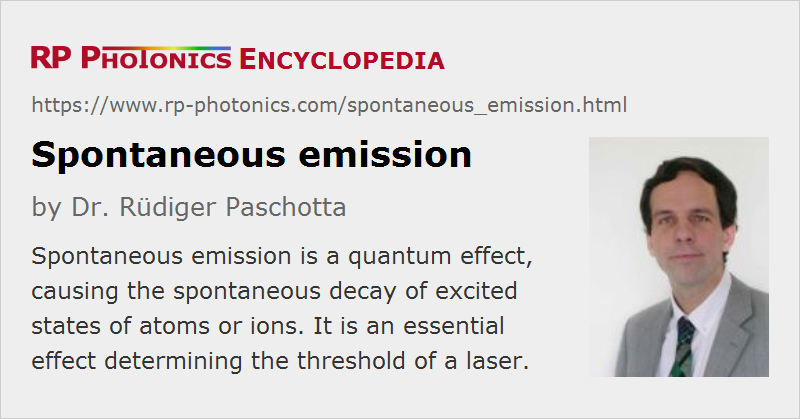Spontaneous Emission
Definition: a quantum effect, causing the spontaneous decay of excited states of atoms or ions
Opposite term: stimulated emission
German: spontane Emission
Categories: quantum optics, fluctuations and noise
How to cite the article; suggest additional literature
Author: Dr. Rüdiger Paschotta
When an atom (or a laser ion in a gain medium) is excited into a higher-lying energy level, e.g. by absorption of a photon, it may after some time spontaneously return to its ground state, or to some intermediate energy level, by releasing the energy in the form of a photon, which carries the energy in some random direction. (More precisely, the photon can correspond to any propagation mode of the medium surrounding the atom or ion.) This process is called spontaneous emission.
Spontaneous emission is a quantum effect, which in a semiclassical picture can be described as an emission which is stimulated by vacuum noise, i.e. by the zero point fluctuations of the optical field. This view is supported by the fact that spontaneous emission can be suppressed or modified by placing an atom or ion in a microcavity structure, which modifies the mode structure of the optical field.
The rate of spontaneous emission (and thus the lifetime of the excited level) is determined both by the properties of the atom and by the mode structure of the surrounding medium. For an atom in free space (or in a homogeneous medium), transition cross sections can be used for calculating the rate of spontaneous emission events (→ radiative lifetime). Typical upper-state lifetimes of atoms are a few nanoseconds if there are allowed transitions to lower levels; much longer values can occur for forbidden transitions.
Light produced by spontaneous emission is called luminescence. The luminescence emitted by a laser gain medium typically carries a total power which equals around one-tenths to one-third of the laser's output power. The optical spectrum of the luminescent light is essentially governed by transition cross sections.
Questions and Comments from Users
Here you can submit questions and comments. As far as they get accepted by the author, they will appear above this paragraph together with the author’s answer. The author will decide on acceptance based on certain criteria. Essentially, the issue must be of sufficiently broad interest.
Please do not enter personal data here; we would otherwise delete it soon. (See also our privacy declaration.) If you wish to receive personal feedback or consultancy from the author, please contact him e.g. via e-mail.
By submitting the information, you give your consent to the potential publication of your inputs on our website according to our rules. (If you later retract your consent, we will delete those inputs.) As your inputs are first reviewed by the author, they may be published with some delay.
Bibliography
| [1] | D. Kleppner, “Inhibited spontaneous emission”, Phys. Rev. Lett. 47 (4), 233 (1981), doi:10.1103/PhysRevLett.47.233 |
| [2] | J. J. Sanchez-Mondragon and N. B. Narozhny, “Theory of spontaneous-emission line shape in an ideal cavity”, Phys. Rev. Lett. 51 (7), 550 (1983), doi:10.1103/PhysRevLett.51.550 |
| [3] | H. Summers et al., “Spontaneous emission control in quantum well laser diodes”, Opt. Express 2 (4), 151 (1998), doi:10.1364/OE.2.000151 |
| [4] | S. Noda et al., “Spontaneous emission control by photonic crystals and nanocavities”, Nature Photon. 1, 449 (2007), doi:10.1038/nphoton.2007.141 |
See also: stimulated emission, quantum noise, radiative lifetime, upper-state lifetime, transition cross sections, fluorescence, laser threshold, parametric fluorescence
and other articles in the categories quantum optics, fluctuations and noise
 |







2020-05-27
Does the rate of spontaneous emission depend on the detuning parameter?
Answer from the author:
Yes, it does, if you put the emitting atom into a micro-resonator and consider the tuning between the natural emission frequency and the closest resonance frequency of the resonator.